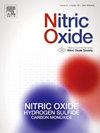血清和尿一氧化氮代谢物与脂肪肝指数之间的关系:一项基于人群的研究。
IF 3.2
2区 生物学
Q2 BIOCHEMISTRY & MOLECULAR BIOLOGY
引用次数: 0
摘要
背景和目的:我们研究了空腹血清和尿一氧化氮代谢物(NOx)水平与脂肪肝指数(FLI)之间的关系,FLI是一种非酒精性脂肪性肝病(NAFLD)和肝脏脂肪变性的无创替代指标。方法:本横断面研究纳入了参加德黑兰脂质和葡萄糖研究(2015-2017)的598名成年人(年龄≥18岁,48.6%为男性)。在Griess反应后,用分光光度法定量测定血清和尿液NOx浓度。使用γ-谷氨酰转移酶、甘油三酯、体重指数和腰围计算FLI值。尿和血清nox -肌酐(Cr)比值[作为一个分类变量,即分位数,或作为一个连续变量,即每1 SD)与NAFLD(即FLI≥60)之间的关系使用多变量调整的二元逻辑回归进行评估。结果:研究对象的平均(SD)年龄为42.5±14.6岁,血清和尿液NOx的平均(SD)分别为37.5±16.7和1310±751 μmol/L。FLI的平均值(SD)为43.3±30.2,NAFLD患病率为32.4%。血清nox - cr比值与NAFLD发生率无相关性(OR=1.66, 95% CI=0.98-2.82;P值= 0.058)。较高的尿nox - cr比值与NAFLD发生率降低显著相关(OR=0.61, 95% CI=0.38-0.95, OR=0.54, 95% CI=0.34-0.87,在第二和第三分位)。结论:较高的膳食硝酸盐(NO3)摄入量(表现为尿nox / cr比值增加)与NAFLD的可能性降低相关,突出了膳食NO3在肝脏健康中的潜在作用。本文章由计算机程序翻译,如有差异,请以英文原文为准。
The association between serum and urinary nitric oxide metabolites and fatty liver index: a population-based study
Background and aim
We investigated the association between fasting serum and urinary nitric oxide metabolite (NOx) levels and fatty liver index (FLI), a non-invasive surrogate of non-alcoholic fatty liver disease (NAFLD) and liver steatosis. Method: This cross-sectional study included 598 adults (aged≥18 years, 48.6 % men) who participated in the Tehran Lipid and Glucose Study (2015–2017). Serum and urine NOx concentrations were quantified using a spectrophotometric method following the Griess reaction. FLI values were calculated using γ-glutamyl transferase, triglycerides, body mass index, and waist circumference. The associations between urinary and serum NOx-to-creatinine (Cr) ratio [either as a categorical variable, i.e., tertiles, or as a continuous variable, i.e., per 1 SD) with NAFLD (i.e., FLI≥60) were assessed using multivariable-adjusted binary logistic regression.
Results
The study participants' mean (SD) age was 42.5 ± 14.6 y. The mean (SD) of serum and urinary NOx was 37.5 ± 16.7 and 1310 ± 751 μmol/L, respectively. The mean (SD) of FLI was 43.3 ± 30.2, and the prevalence of NAFLD was 32.4 %. Serum NOx-to-Cr ratio was not associated with the chance of having NAFLD (OR = 1.66, 95 % CI = 0.98–2.82; P value = 0.058). Higher urinary NOx-to-Cr ratio was significantly associated with a reduced probability of NAFLD (OR = 0.61, 95 % CI = 0.38–0.95, and OR = 0.54, 95 % CI = 0.34–0.87, in the second and third tertiles).
Conclusion
Higher dietary nitrate (NO3) intake, indicated by increased urinary NOx-to-Cr ratio, is associated with a reduced probability of NAFLD, highlighting the potential role of dietary NO3 in liver health.
求助全文
通过发布文献求助,成功后即可免费获取论文全文。
去求助
来源期刊

Nitric oxide : biology and chemistry
生物-生化与分子生物学
CiteScore
7.50
自引率
7.70%
发文量
74
审稿时长
52 days
期刊介绍:
Nitric Oxide includes original research, methodology papers and reviews relating to nitric oxide and other gasotransmitters such as hydrogen sulfide and carbon monoxide. Special emphasis is placed on the biological chemistry, physiology, pharmacology, enzymology and pathological significance of these molecules in human health and disease. The journal also accepts manuscripts relating to plant and microbial studies involving these molecules.
 求助内容:
求助内容: 应助结果提醒方式:
应助结果提醒方式:


